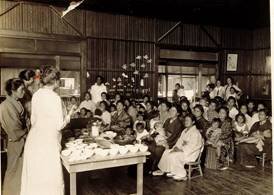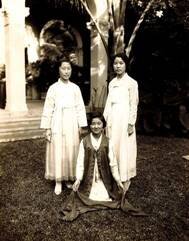A Moment in Our History: Early Immigrants Work and Live in Honolulu
Our board and staff tackled a number of tasks in the early 1900’s as YWCA established its local presence. Those included providing physical education and creating a boarding home. Another primary goal was assisting those who came to Hawai'i from elsewhere. In fact, within one year of the establishment of YWCA O'ahu, the board created a “Strangers Committee” to assist newcomers who arrived in Honolulu with no knowledge of Hawai'i.
One example: Our “Travelers’ Aid Secretary” used to show up at Pier 12 of Honolulu Harbor at 11:00pm, remaining there until 6:00am to assist women, domestic and foreign, who “arrived before daylight and had no way of reaching their destination.”
Honolulu Star-Bulletin: October 8, 1919
YWCA O'ahu also provided the necessities to make the woman’s restroom pleasant such as a couch, towels, soap, clean linen and furnished janitorial service of the room so that women could freshen up after long hours of travel.
The Honolulu Advertiser: November 28, 1924
As the country experienced a surge in immigration, assisting foreign-born women became one of the core works of the YWCA across the nation, including O'ahu. With the increased arrival of plantation workers at the turn of the century came the picture brides. YWCA O'ahu started hiring staff who spoke the languages of those immigrant women and understood their cultures.
Honolulu Star-Bulletin: August 30, 1917
YWCA O'ahu hired Mrs. Tsue Kishimoto to assist picture brides from Japan. Mrs. Kishimoto is fourth from the left in the first row standing with then board president Mrs. Walter F. Frear.
The YWCA sent staff to countries like Japan to assist women even prior to their arrival to the United States by establishing a hotel where they could stay before sailing for Hawaii, providing instructions in American manners and customs and assisting them in complying with immigration requirements.
Honolulu Star-Bulletin: May 30, 1919
Japanese English Class in 1924
Our efforts expanded further with the opening of the International Institute in 1919. The work of “Americanization” had been taking place across the country to help foreign-born individuals assimilate into life in America and YWCA O'ahu made it part of its mission work in the community. Some YWCA staff members, including one who had been working among the picture brides at Angel Island in San Francisco, were assembled in Honolulu to assist the creation of the institute.
English Class in 1924
Speaking at the annual meeting of the association, Sue Barnswell, national immigration secretary of the YWCA spoke of the importance of the Americanization work.
“Can you afford to be passive when four-fifths of your population do not understand the ideals of America, many of whom do not understand the language, and whose birth rate is nine times that of ours?”
English Class at Japanese Hospital in 1923
One of the primary reasons for establishing the institute was to solve the “misunderstanding between the mother who has grown up in a foreign land, and the young girl who has become Americanized.” The YWCA staff observed that it was this misunderstanding that was responsible for “a great many of the cases which come up in the juvenile court.” The sessions were created specifically for women to address their issues. Another club was created for girls.
1920 Iwilei Filipino English Class
The Institute had the Hawaiian name Ka Hale Kokua (The House of Friendly Help) and opened in June of 1919 on Nuuanu Street under the leadership of Miss Elsie Wilcox. Its staff consisted of one Japanese, one Chinese, one Korean and one Filipino member based on a philosophy that “immigrants can be reached properly only through workers who speak their own language.” English was a harder language to master for Asian immigrants than those from Europe.
Interracial cooking Class in 1920
In addition to the main classes such as English and American culture and customs, other life enrichment classes were offered – sewing, cooking and music. Women came to the institute to learn but staff members often travelled to the neighborhoods where those immigrants were and gave classes when needed. The neighborhood classes were “particularly valuable for the Chinese women, many of whom are unable to travel to the institute building from distant parts of the city on account of their small feet.” Although the practice was outlawed in 1912, the immigrant Chinese women at that time experienced the ancient practice of foot binding which made it difficult for them to walk long distances.
Classes were taught outside of the Institute to meet the needs of immigrant women. (Kakaako Mothers Club 1923)
Miss Nell Findlay who presided over the Institute described her work as follows:
“One of my favorite classes is held at the home of one of the members. The lady of the house sits with a twin in each arm and her book propped up in the middle, while others of the neighborhood come in one by one carrying sleeping children and perhaps carrying some of their household work with them. The earnestness of purpose and effort which they apply to the work is amazing.”
Miss Nell Findlay of Oakland returned from war service in Verdun and joined Ka Hale Kokua
While helping immigrant women assimilate to the culture of the United States, International Institute often created opportunities to help them perpetuate and share their own cultures.
Pioneer Days in Hawaii Play in 1932
Chinese play 1924
Japanese program in 1928
Korean Girls Club High School Tea in 1932
The work of the Institute continued well into the 50’s. Although the direct work of the Institute no longer exists, its influence and impact continues to touch the generations of immigrants.
Honolulu Star-Bulletin: December 21, 1959
International Institute Event in 1950
Cookbooks were a great way to share one’s culture
-Noriko Namiki, YWCA O‘ahu CEO



















